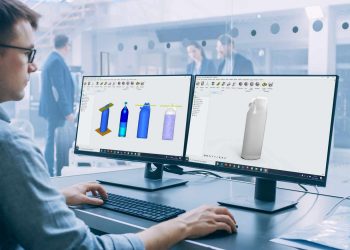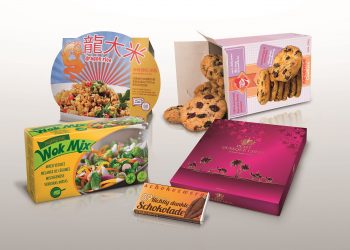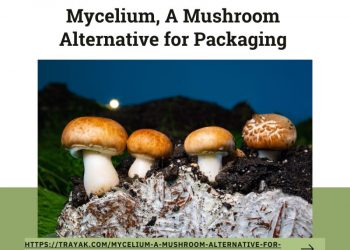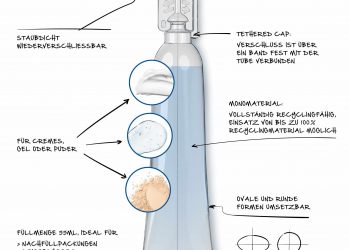Plastic containers, plastic cutlery, plastic bottles & pouches, have all played a big role in the trend of flexible, on-the-go packaging during the last couple of years. Consumers used to love this type of packaging due to its convenience, being a light material, cheap, easy to transport, wash & deposit. However, raising concerns regarding material recycling, CO2 emissions, and the search for more sustainable solutions, pushed producers to take responsibility and shift towards environmentally friendly alternatives to plastic packaging.
When talking about sustainable packaging, there are typically two approaches: first, how can we recycle current materials more efficiently, and second, how can we develop new and better packaging solutions. Evidently, scientific research is making great efforts towards developing innovative sustainable packaging solutions, such as bioplastics. However, sustainability may perhaps be achieved faster and easier by using what is already known and available in terms of packaging material.
In the past couple of years, the tendency of switching from plastic to more sustainable materials has been obvious and extremely encouraged. Depending on the type of product, of course, producers and processors are doing their best to find a more environmentally- friendly alternative. Solid products that are currently packed in plastic, can easily be rebranded and re-packed in recycled paper/cardboard alternatives, or even bioplastic as mentioned above. In case of e.g. liquid/fluid products, and/ or thermally sensitive products, paper/cardboard cannot fulfill the complete role of protecting & maintaining product integrity and quality. This is the reason why, typically, this type of packaging lines is likely to implement glass as an alternative. The purpose of this paper is to exemplify the risks of foreign body contamination that may arise in a production & packaging line when glass is used as the main packaging material, and what type of solution can best ensure product quality and safety.
Glass packaging as a sustainable alternative
Why does glass seem to be the obvious choice for a sustainable packaging alternative? Shortly, it is because of characteristics related to the ability of recycling this material, compared to plastic. First, the recovery percentage for recycling glass is among the highest compared to single use plastic, carton or aluminium. One of the most unique characteristics of glass is that, at least in the case of brown colored glass, the recycling flux is infinite. Even though current data suggests that carbon footprint rates of single use plastics may be the same or even a bit lower than glass, the negative impact of plastic in pollution levels is much higher than glass. Yes, it is also true that the decomposing time of glass is much longer than single use plastic or aluminium, but the impact on nature and animals is minimal in the case of glass. If we were to compare the advantages vs. the disadvantages of using glass as packaging material, the following aspects are worth mentioning:
Disadvantages –
• weight (glass can be quite heavy) • easy to break • dangerous because of the glass splinters that may result from breaking • difficult to handle • requires significant energy to recycle
Advantages –
• standardized material • recyclable • cheap, compared to other materials • clear, smooth surfaces • inert and used in many hygienic and sterile contexts (e.g. pharma industry)

Fig. 1. Illustration explaining the how can safe glass packaging contribute to achieving United Nations Sustainable Development Goal 12: Responsible Consumption and Production.
So why aren’t all producers and processors of liquid/fluid products replacing plastic and aluminium with glass? The answer may lead to product safety concerns. Glass is unfortunately a delicate material for which, in the context of a complex production line where products are transported on bands, handled, turned & packed, the risk of breakage is evidently much higher than other packaging materials. Depending on the product, HACCP (Hazard Analysis and Critical Control Points) Systems are more basic, or more strictly requested and implemented in production lines.
Packaging material as a physical contamination source
Opting for a certain packaging material will influence the packaging process and finally the physical contamination risk, probability and occurrence. Hazard analysis includes the assessment of biological, chemical and physical contamination analysis in a food production line. Part of the physical contamination list are often objects or fragments of materials found in the production and processing line, elements that may contaminate food in different ways. Including the packaging of the product in the list of risk assessment is therefore, in certain cases, extremely important.
Physical contamination with glass is considered a major safety hazard, which is carefully monitored and assessed through a glass management program. The issue is that, typically, HACCP systems search to identify, analyze and control physical contamination with foreign objects. These can be material fragments that are picked up by the product during production, sometimes as a result of an equipment malfunction and breakage, crosscontamination, etc. In the case of glass, the packaging itself can become a source of physical contamination. It is typically liquid/fluid food products that get packed in glass packages, bottles and containers. This also raises a few problems. If the food product has a higher temperature at the moment of filling up the recipient, the risk of an internal glass fracture significantly increases. Internal fractures typically result in very sharp and small glass shards that will afterwards spread in the product and are very difficult to detect.
Safety & Quality Assurance
Opting for a sustainable packaging alternative should not a very complex and costly process for food producers. Naturally, everybody would like to experience a smooth transition from one packaging method to another, without huge costs and without replacing the entire production line. Therefore, it is important to choose a quality inspection method that will complement the already existing equipment, and that will add value to the entire production process. Handling glass packaging during production will inevitably result at some point in a certain packaging irregularity or defect episode, just like any other type of packaging line. Therefore, it is important to be prepared with the right type of integrity assessment system that will help identify even the smallest packaging fractures.
Different inspection systems for different purposes
If the glass fracture occurs in the packaging exterior, a vision system will be able to inspect the surface of the bottle/recipient and identify the location of the defect. The situation becomes more complex when the fracture occurs on the inside of the packaging. In this case, vision systems are not able to efficiently spot the defect since they cannot penetrate the surface of the glass. Things get even more complicated when taking into consideration the fact that the bottom of glass recipients is typically thicker. Production lines that use glass packaging have different methods of rinsing and cleaning the recipients before the filling process. While air blowing is quite a common method for making sure that the interior of glass packages is clean, there may still be irregular fragments of glass sticking out as a result of a faulty glass binding. The air-blowing technique is not strong enough to remove these fragments, but they do unfortunately tend to break from the heaviness of the liquid being poured into the packaging later in the process. This is a typical occurrence of foreign body contamination with glass splinters, from the glass packaging itself. In this case, the vision system has no chance of spotting the defect, since it is not able to penetrate the surface of the glass.
X-ray technology, on the other hand, can penetrate the surface of the glass but there will be variations in the level of detail and clarity that can be picked up, depending on the scintillation of the X-ray detector. X-ray systems used for food inspection, especially for contaminants detection, are very much similar in terms of the fundamental technical basis for the acquisition of the X-ray images. The technology is thus based on using 0.4 or 0.8 mm pixels, which detects the electrical or optical signal from a scintillator that converts the X-ray photon image.

Fig. 2. Example of detection capability of a standard system. Identified large glass pieces are indicated. Note the large dimension of detected objects and cutting off about 40% of the jar volume (blue area).
The scintillator used in standard X-ray inspection systems is based on Gadox, a robust, cheap and well-known material for X-ray imaging. New developments have brought in new scintillation materials. Among others, low-energy X-ray technology has proven very attractive due to a very high efficiency in converting the X-ray photon image, and a very good efficiency also at energies below 25 keV, where Gadox is ineffective. Due to this, low-energy X-ray technology provides very high contrast images.

Fig. 3. Less than 2 mm glass piece detected using the novel high sensitivity technology. Note the position of the glass piece close to the bottom
At the same time, a very small pixel size is possible without excessive noise, due to the high conversion efficiency. This is especially relevant and important when trying to identify physical contamination with small glass splinters. As previously mentioned, the highest risk for internal breakage is the bottom of the glass recipient where glass is thickest, so standard X-ray technology will also have difficulties in spotting small details such as extremely small fragmentation and glass splinters.
The above is testified by current X-ray systems used for glass detection not being able to detect very small glass pieces that are the most dangerous for consumers.
As also shown, the current technology, in some cases, makes it difficult or impossible to detect glass fragments close to the walls of the jar. In fact, in some cases 40 % of the volume remains un-inspected.
The high contrast, high resolution imaging made possible integrating new low-energy detection technology as a glass-in-glass detection system integrated with fast, robust and reliable automatic glass splinter detection algorithm. This enables even the tiniest glass fragments to be detected, even when placed next to the glass wall.
Sustainability & Product quality and safety, hand in hand

Fig. 4. Illustration explaining the how can safe glass packaging contribute to encouraging food producers to choose sustainable packaging alternatives without compromising on product safety.
In conclusion, choosing a sustainable packaging material should not be a compromise on the quality and safety of the product. Glass packaging is certainly a better packaging option for the environment but making the switch from plastic to glass should involve serious considerations on how the risk of physical contamination with glass fragments can be identified, controlled and minimized in the packaging line. Depending on the type of glass recipient, as well as the type of product filling the recipient, the chosen quality assurance measurement must be technologically capable to identify and assess the physical contamination with as high and as accurate as possible detection capability rates. All this, for a better environment in the future and safer products for consumers.
Jørgen Rheinlaender is the founder of InnospeXion, a company with a 20 year record on producing high sensitivity, high contrast X-ray imaging solutions for a vast number of applications. Since 2011, InnospeXion has supplied advanced autonomous X-ray systems to the fish processing industry. The experiences and advantages of the technology has been successfully deployed for automatic bone detection in the poultry processing industry for the last 5 years.






